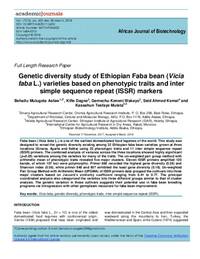Genetic diversity study of Ethiopian Faba bean (Vicia faba L.) varieties based on phenotypic traits and inter simple sequence repeat (ISSR) markers

Authors:
Faba bean (Vicia faba L.) is one of the earliest domesticated food legumes of the world. This study was designed to reveal the genetic diversity existing among 32 Ethiopian faba bean varieties grown at three locations (Sinana, Agarfa and Selka) using 23 phenotypic traits and 11 inter simple sequence repeat (ISSR) primers. The combined analysis of variance across the three locations showed highly significant (p<0.05) variations among the varieties for many of the traits. The un-weighted pair group method with arithmetic mean of phenotypic traits revealed five major clusters. Eleven ISSR primers amplified 120 bands, of which 107 loci were polymorphic. Primer 860 recorded the highest gene diversity (0.38) and Shannon index (0.56), while primer 848 and 857 exhibited the least gene diversity (0.18). Un-weighted Pair Group Method with Arithmetic Mean (UPGMA) of ISSR primers data grouped the cultivars into three major clusters based on Jaccard’s similarity coefficient ranging from 0.41 to 0.77. The principal coordinated analysis also categorized the varieties into three different groups similar to that of cluster analysis. The genetic variation in these cultivars suggests their potential use in faba bean breeding programs via introgression with other germplasm resources for faba bean improvement.
